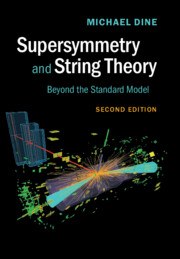Book contents
- Frontmatter
- Dedication
- Contents
- Preface to the First Edition
- Preface to the Second Edition
- A note on the choice of metric
- Text website
- Part 1 Effective field theory: the StandardModel, supersymmetry, unification
- Part 2 Supersymmetry
- 9 Supersymmetry
- 10 A first look at supersymmetry breaking
- 11 The Minimal Supersymmetric Standard Model
- 12 Supersymmetric grand unification
- 13 Supersymmetric dynamics
- 14 Dynamical supersymmetry breaking
- 15 Theories with more than four conserved supercharges
- 16 More supersymmetric dynamics
- 17 An introduction to general relativity
- 18 Cosmology
- 19 Particle astrophysics and inflation
- Part 3 String theory
- Part 4 Appendices
- References
- Index
13 - Supersymmetric dynamics
from Part 2 - Supersymmetry
- Frontmatter
- Dedication
- Contents
- Preface to the First Edition
- Preface to the Second Edition
- A note on the choice of metric
- Text website
- Part 1 Effective field theory: the StandardModel, supersymmetry, unification
- Part 2 Supersymmetry
- 9 Supersymmetry
- 10 A first look at supersymmetry breaking
- 11 The Minimal Supersymmetric Standard Model
- 12 Supersymmetric grand unification
- 13 Supersymmetric dynamics
- 14 Dynamical supersymmetry breaking
- 15 Theories with more than four conserved supercharges
- 16 More supersymmetric dynamics
- 17 An introduction to general relativity
- 18 Cosmology
- 19 Particle astrophysics and inflation
- Part 3 String theory
- Part 4 Appendices
- References
- Index
Summary
In the previous chapter, we learned how to build realistic particle physics models based on supersymmetry. There are already significant constraints on such theories, and experiments at the LHC will test whether these sorts of ideas are correct.
If supersymmetry is discovered, the question will become: how is supersymmetry broken? Supersymmetry breaking offers particular promise for explaining large hierarchies. Consider the non-renormalization theorems. Suppose that we have a model consisting of chiral fields and gauge interactions. If the superpotential is such that supersymmetry is unbroken at tree level, the non-renormalization theorems for the superpotential which we proved in Section 9.7 guarantee that supersymmetry is not broken to all orders of perturbation theory. But they do not necessarily guarantee that effects smaller than any power of the couplings will not break supersymmetry. So, if we denote the generic coupling constants by g2, there might be effects of order, say, which break the symmetry. In the context of a theory like the MSSM, supposing that soft breakings are of this order might account for the wide disparity between the weak scale (correlated with the susy-breaking scale) and the Planck or unification scale.
So, one reason why the dynamics of supersymmetric theories is of interest is its role in aiding our understanding of dynamical supersymmetry breaking and perhaps in studying a whole new class of phenomena in nature. But there are yet other reasons to be interested, as was first clearly appreciated by Seiberg. Supersymmetric Lagrangians are far more tightly constrained than ordinary Lagrangians. It is often possible to make strong statements about the dynamics which would be difficult if not impossible for conventional field theories. We will see this includes phenomena such as electric–magnetic duality and confinement.
Criteria for supersymmetry breaking: the Witten index
We will consider a variety of theories, some of them strongly coupled. One might imagine that it is a hard problem to decide whether supersymmetry is broken. Even in weakly coupled theories, one might wonder whether one could establish reliably that supersymmetry is not broken since, unless one has solved the theory exactly, it would seem hard to assert that there is no tiny non-perturbative effect which does not break the symmetry. One thing we will learn in this chapter is that this is not, however, a particularly difficult problem. We will exploit several tools.
- Type
- Chapter
- Information
- Supersymmetry and String TheoryBeyond the Standard Model, pp. 182 - 197Publisher: Cambridge University PressPrint publication year: 2016



